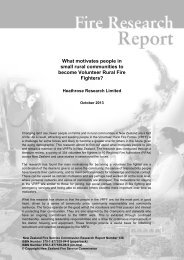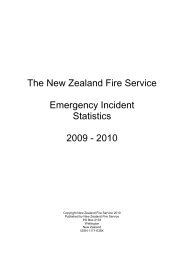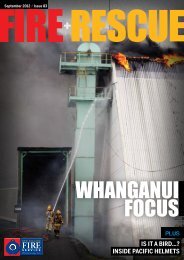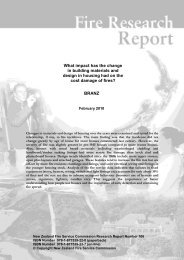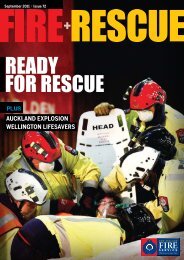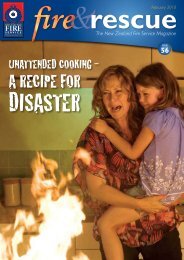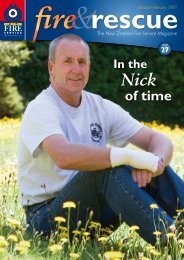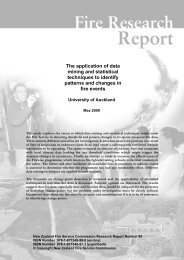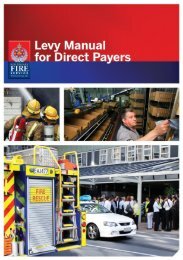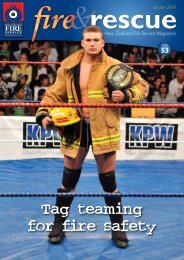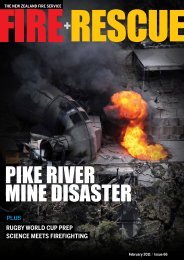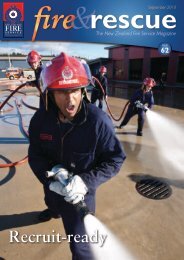Fire & Rescue issue 5.indd - New Zealand Fire Service
Fire & Rescue issue 5.indd - New Zealand Fire Service
Fire & Rescue issue 5.indd - New Zealand Fire Service
Create successful ePaper yourself
Turn your PDF publications into a flip-book with our unique Google optimized e-Paper software.
Dec 2004/Jan 2005 – Issue No. 5<br />
The <strong>New</strong> <strong>Zealand</strong> <strong>Fire</strong> <strong>Service</strong> Magazine<br />
Christmas Spirit
December 2004/January 2005<br />
Issue No. 5<br />
<strong>Fire</strong> & <strong>Rescue</strong> is the fl agship<br />
publication of the <strong>New</strong> <strong>Zealand</strong><br />
<strong>Fire</strong> <strong>Service</strong>.<br />
It is produced by Media,<br />
Promotions and Communications,<br />
National Headquarters,<br />
Level 9, 80 The Terrace, Wellington.<br />
We are happy to consider ideas<br />
for stories and features.<br />
Cover picture<br />
Station offi cer Dave Woon (rear)<br />
left to right senior fi refi ghter Peter Cranwell,<br />
fi refi ghters Peter Langford and Matthew Salt<br />
at the offi cial opening of the famous<br />
Christmas lights in Franklin Road, Ponsonby.<br />
Story: Page 27.<br />
Photos: Dean Treml.<br />
Contact us by email at:<br />
Susan.grant@fi re.org.nz<br />
Tel: 04-496-3716<br />
Or write to:<br />
Editor,<br />
<strong>Fire</strong> & <strong>Rescue</strong> Magazine,<br />
NZ <strong>Fire</strong> <strong>Service</strong>,<br />
P O Box 2133,<br />
Wellington<br />
<strong>Fire</strong> & <strong>Rescue</strong> is online at<br />
www.fi re.org.nz<br />
ISSN: 1176-6670<br />
All material in <strong>Fire</strong> & <strong>Rescue</strong> magazine is<br />
copyrighted and may not be reproduced<br />
without the permission of the editor.<br />
7<br />
8 14<br />
SMS update<br />
Identifying risk – SMS in action ...................................................................................3<br />
<strong>New</strong> initiatives<br />
Sockburn labels add courtesy to call-outs ..................................................................4<br />
On-line ordering for national promotional resources... .........................................5<br />
<strong>New</strong> complaints feedback policy developed .............................................................6<br />
<strong>Fire</strong>fi ghters’ views sought on <strong>Fire</strong> <strong>Service</strong> future ......................................................6<br />
National training facility project blessed ......................................................................7<br />
Highway hero’s fi re skills save a life - twice ..............................................................7<br />
Appointment<br />
Special ops “Ninja” ...................................................................................................................8<br />
Incidents<br />
Diffi cult incident in Wellington crane .............................................................................9<br />
<strong>Fire</strong> blackens Christmas plans ........................................................................................10<br />
Windy Wanganui ...................................................................................................................11<br />
Refl ections of a storm .........................................................................................................11<br />
Joint exercise tests ship fi re skills ..................................................................................11<br />
Hydrogen peroxide spill .....................................................................................................12<br />
Birds under the bonnet .......................................................................................................12<br />
Driver cut out of car .............................................................................................................12<br />
Forced landing .........................................................................................................................13<br />
Timber yard incident ............................................................................................................13<br />
Training<br />
Canterbury gears up for summer heat .....................................................................14<br />
Prepared for the fi re season ............................................................................................16<br />
<strong>Fire</strong> safety<br />
Civic award in Palmerston North ..................................................................................17<br />
What goes on behind closed doors? ...........................................................................18<br />
Ignored smoke alarms prompt safety day out .....................................................20<br />
Keeping abreast of fi re safety ........................................................................................21<br />
Free barbeque .........................................................................................................................21<br />
<strong>Fire</strong> message delivered to rural schools ....................................................................22<br />
<strong>Fire</strong>Wise gets a fresh approach ....................................................................................22<br />
Profi le NGARUAWAHIA ....................................................................................................23<br />
Snapshots<br />
Wellington Gold Star Tournament ................................................................................17<br />
Sports Council Event Calendar 2005 ........................................................................20<br />
Saudi fi refi ghter proves the brotherhood ..................................................................24<br />
Hamilton plans to top record cancer walk .............................................................25<br />
Auckland tennis and squash ...........................................................................................25<br />
<strong>Fire</strong> crews meet the World’s Fastest Indian ............................................................26<br />
<strong>New</strong> orientation programme ..........................................................................................26<br />
Cover story<br />
The spirit of Christmas in Ponsonby ............................................................................27<br />
16 22 26
SMS update<br />
Identifying risk –<br />
SMS IN ACTION<br />
The work Timaru fi refi ghters (pictured) are doing to identify properties at greater risk<br />
in their patch is an example of the station management system (SMS) in action.<br />
Every fi re station needs to break its<br />
goals down into something that is<br />
relevant to the fi re risks in its patch<br />
and which ones are likely to need<br />
fi refi ghters’ attention, says director,<br />
strategic development Ian Pickard.<br />
To do this they must identify the risks<br />
within their patch and what they plan<br />
to do to reduce those risks. This<br />
action requires a process of risk<br />
analysis. There are a number of ways<br />
that this analysis can be carried out:<br />
• Using emergency response<br />
statistics to identify trends<br />
• Using the statistics available on<br />
the social and economic<br />
deprivation index<br />
• Using their local knowledge of<br />
their patch<br />
“In many cases it is a combination of<br />
all three and then using a community<br />
fi re risk management principle they<br />
can then decide on the specifi c risk<br />
reduction goals and targets within a<br />
certain patch.”<br />
The community fi re risk management<br />
process is a way that allows fi refi ghters<br />
to identify, prioritise and manage the<br />
fi re risk at a local level.<br />
Senior station offi cer Martyn Bennett (left)<br />
and fi refi ghter Gary Harford rate another<br />
home for its fi re risk as part of a survey of<br />
every property in Timaru. This is an example<br />
of the station management system in action.<br />
Information is collected on all<br />
buildings and occupancy types within<br />
their patch and is recorded and stored<br />
electronically in an information<br />
management system as part of SMS.<br />
Each building and activity carried out<br />
in the building is given a fi re risk score<br />
that is then compared across all<br />
buildings in a geographical area to<br />
decide on what fi re safety advice can<br />
be targeted to the owners, managers,<br />
and occupiers of the buildings that<br />
score the worst fi re risk total.<br />
“The information that firefighters<br />
collect on buildings and occupancy<br />
types does improve their knowledge<br />
of fi re risk within their patch. Then<br />
by using their operational knowledge<br />
and experience of fi re they can then<br />
plan far better fi re safety advice and<br />
response solutions to building owners<br />
and members of the public,” Ian<br />
says.<br />
This information is then transposed<br />
into station goals and targets as part<br />
of their station or watch business<br />
plan and loaded into station and<br />
watch targets as part of SMS.<br />
SMS is far more than a computer<br />
recording system. It is a total concept<br />
and principle of having fi refi ghters<br />
being more involved in the planning,<br />
and day to day management of their<br />
activities against the key objectives as<br />
outlined in the <strong>Fire</strong> <strong>Service</strong> strategic<br />
plan, Ian says<br />
<strong>Fire</strong> stations must understand how<br />
those strategic objectives relate to the<br />
specifi c goals set in their business plan<br />
and just how they can plan their work<br />
to ensure that the work they carry out<br />
actually helps their district and the<br />
organisation to achieve these goals,<br />
he says.<br />
The <strong>New</strong> <strong>Zealand</strong> <strong>Fire</strong> <strong>Service</strong> Magazine December 2004/January 2005<br />
Photo courtesy Timaru Herald<br />
3
<strong>New</strong> initiatives<br />
Sockburn labels add<br />
courtesy to call-outs<br />
Key tags and courtesy stickers have added<br />
dimension to the courtesies required when<br />
fi refi ghters have to enter vacant premises.<br />
The initiatives were developed by<br />
brown watch, Sockburn, in<br />
Christchurch who would like to share<br />
the concepts with other brigades.<br />
Senior station offi cer Dave Mitton<br />
says the brigade now carries key tags<br />
along with combination padlocks for<br />
those occasions when crews have to<br />
force entry, but must ensure things<br />
are secure when they leave.<br />
The key tag and the combination lock<br />
means crews can not only secure the<br />
premises – such as a farmer’s gate or<br />
a shed - before they leave but can also<br />
leave behind the message that the<br />
premises was entered by the <strong>Fire</strong><br />
<strong>Service</strong> as a result of a call-out. The<br />
tag includes a space for the name of<br />
the station, the telephone number,<br />
who the offi cer was and date and time<br />
of entry.<br />
“Often when they phone we are able<br />
to simply give the combination out to<br />
the caller and pick up the padlock<br />
4 Issue No. 5<br />
and tag later that day. Within the<br />
week of the tag going on the Sockburn<br />
appliance it was used twice.”<br />
The new stickers also developed by<br />
Sockburn are used when the brigade<br />
attends calls such as after hours PFAs,<br />
when the building is secure and noone<br />
is around.<br />
“We thought it was only courtesy<br />
that the occupier should be informed<br />
we have entered their building or<br />
attended an incident as the result of a<br />
call-out, and leave a contact name.”<br />
“There are security <strong>issue</strong>s involved<br />
here where we felt that if we enter<br />
into someone’s premises after hours<br />
they should be informed we were<br />
there. Should they have any queries<br />
the owner or tenant is able to contact<br />
the officer who attended, as the<br />
information is written onto the label<br />
in marker pen and stuck to the corner<br />
of a desk, or external door for them<br />
Key tag and sticker developed by brown watch,<br />
Sockburn. Senior station offi cer Dave Mitton is<br />
happy to talk to any brigades who would like to<br />
follow up these initiatives for themselves.<br />
Senior fi refi ghter Ross Trezise,<br />
brown watch, Sockburn, helped the<br />
crew develop the key tag and sticker<br />
initiatives.<br />
to see when they come to work the<br />
next day.”<br />
Dave says it helps raised the profi le of<br />
the service because often the public<br />
does not know firefighters have<br />
entered the building looking for a<br />
fi re.<br />
He says this fi ts in with working with<br />
communities to protect what they<br />
value.<br />
The stickers are also useful when<br />
fi refi ghters attend rural fi res and enter<br />
farm land, or fi res in road-side rubbish<br />
skips.<br />
Contact senior<br />
station offi cer<br />
Dave Mitton if you<br />
are interested in<br />
following up this<br />
initiative.
On-line ordering for national<br />
promotional resources<br />
A new on-line order system is being developed for<br />
fi refi ghters to order their own national promotions<br />
material to support fi re safety initiatives in their<br />
communities.<br />
On-line ordering has been created to<br />
support the organisation’s direction<br />
of fi refi ghters managing risk in their<br />
communities through business plans,<br />
which is why this feature will only be<br />
available via the station management<br />
system (SMS).<br />
Access into the system has been<br />
offered to career fi refi ghting personnel<br />
from chief fi re offi cer to station offi cer<br />
rank, key regional promotions and<br />
fire safety personnel, volunteer<br />
support offi cers and volunteer chief<br />
fi re offi cers.<br />
A range of national resources will be<br />
available to order including all<br />
national promotions brochures,<br />
pamphlets and booklets, Be <strong>Fire</strong>Wise<br />
programme resources including Maui<br />
Tine Ahi resources and national<br />
promotional giveaway items such as<br />
rulers, stickers and tattoos. These<br />
resources are paid for out of the<br />
national promotions budget.<br />
The system features an image and<br />
description of each resource, printable<br />
and downloadable pdf fi les, a back<br />
order facility, a ‘what’s new’ area to<br />
post information about new items<br />
and a shopping basket facility to<br />
order resources.<br />
Orders will be directed to a warehouse<br />
in Wellington where items will be<br />
picked, packed and sent directly to<br />
fi re stations.<br />
The warehouse aims to provide for a<br />
24-hour turn around within the<br />
North Island and a 72-hour turn<br />
around within the South Island.<br />
The media, promotions and<br />
communications unit will pay for<br />
storage, freight and logistics costs.<br />
A Q&A fact sheet featuring more<br />
information about the system is<br />
available on ‘what’s new’ in <strong>Fire</strong>Net.<br />
Updates and new information about<br />
the on-line order system and new<br />
resources will be published on <strong>Fire</strong>Net<br />
and on the on-line order website.<br />
The system will be available in<br />
January 2005.<br />
<strong>New</strong> initiatives<br />
The <strong>New</strong> <strong>Zealand</strong> <strong>Fire</strong> <strong>Service</strong> Magazine December 2004/January 2005<br />
5
<strong>New</strong> initiatives<br />
<strong>New</strong> complaints<br />
feedback policy<br />
developed<br />
A new policy to assist personnel when dealing with feedback<br />
or a complaint from a member of the public, has recently<br />
been approved by the <strong>Fire</strong> <strong>Service</strong> Commission.<br />
The complaints / feedback policy<br />
(POLCM6.1) provides best practice<br />
guidelines for employees to follow and<br />
establishes a formal process for members<br />
of the public who wish to pass on a<br />
compliment or make a complaint.<br />
Complaints can be made directly to<br />
the person being complained about<br />
and then, if the complainant is not<br />
satisfi ed, to their chief fi re offi cer /<br />
business unit manager.<br />
Any person wishing to pass on a<br />
compliment or make a complaint can<br />
do so via the public website by<br />
emailing feedback.fi re.org.nz or by<br />
returning a freepost feedback form.<br />
A discussion document outlining<br />
three options for the future shape of<br />
fire and rescue services has been<br />
released by Internal Affairs Minister<br />
George Hawkins.<br />
The document outlines three options:<br />
a national model, a modifi ed status<br />
quo model and a national-regional<br />
model. Mr Hawkins is keen to hear<br />
the views of career and volunteer<br />
fi refi ghters.<br />
“<strong>New</strong> laws are needed to recognise<br />
the new tasks being taken on by the<br />
<strong>Fire</strong> <strong>Service</strong>, especially in rescue<br />
work.’’<br />
“There are also inconsistencies<br />
between urban and rural fi re systems.<br />
We need to resolve these.’’<br />
<strong>Fire</strong> services depended heavily on<br />
volunteers and their efforts needed to<br />
be encouraged and maintained, Mr<br />
Hawkins said.<br />
All career stations and areas with<br />
public access will be sent posters<br />
for staff notice boards and other<br />
public / reception areas.<br />
<strong>Fire</strong>fi ghters’ views<br />
sought on <strong>Fire</strong> <strong>Service</strong> future<br />
6 Issue No. 5<br />
All feedback will be logged in the<br />
station management system (SMS)<br />
and the information recorded will be<br />
used to improve our processes where<br />
appropriate.<br />
Feedback forms for the public and<br />
posters explaining the complaints/<br />
feedback policy will be sent to career<br />
fi re stations and business units late<br />
December to January.<br />
The policy is available on <strong>Fire</strong>Net in<br />
the manual, policy, form information<br />
section under communications, media<br />
and promotions national policy<br />
documents.<br />
User-friendly freepost feedback / complaints<br />
forms have been developed for personnel to<br />
give to members of the public that may ask<br />
for them.<br />
“I’m particularly keen to hear the<br />
views of fi refi ghters, both voluntary<br />
and paid, to help ensure we get the<br />
best possible system for the<br />
future.’’<br />
Submissions, to be made to the<br />
Internal Affairs Department, close on<br />
March 31. The discussion document<br />
can be viewed on-line at:<br />
<strong>Fire</strong>LegislationReview@dia.govt.nz<br />
or www.dia.govt.nz
National training<br />
facility project blessed<br />
Nine pieces of greenstone,<br />
representing the eight fi re regions<br />
and national headquarters, were laid<br />
at the entrance to what will be the<br />
new national training facility in a<br />
formal ceremony in November.<br />
Chief Executive/National Commander<br />
Mike Hall and local kaumätua<br />
performed the ceremony in Rotorua<br />
before a gathering that included <strong>Fire</strong><br />
<strong>Service</strong> personnel who have been<br />
involved in the project; Rotorua<br />
deputy mayor Trevor Maxwell and<br />
<strong>Fire</strong> <strong>Service</strong> national adviser, Mäori,<br />
Piki Thomas.<br />
Piki says the stones represented the<br />
‘mauri’ or life-force/essence of the<br />
various regions and headquarters;<br />
having a piece of each region and<br />
headquarters present on the site at all<br />
times that joins with the life force<br />
already in the whenua.<br />
“The position of the stones is of less<br />
signifi cance but have been placed to<br />
welcome ‘their’ respective<br />
representatives from around the<br />
country as they enter the site.”<br />
Recruit programme manager Des<br />
Irving says the project has gone out<br />
for tender. It is on a one hectare site<br />
and the BATB, tower and live fi re<br />
building should be operational by<br />
late next year.<br />
Des says the facility is the <strong>Fire</strong> <strong>Service</strong>’s<br />
fi rst purpose-built national recruit<br />
training centre for fi refi ghting ranks.<br />
Some of its special facilities will<br />
include compartmental fi re training,<br />
with three containers, in a “H”<br />
confi guration set up to offer offensive<br />
and defensive compartmental fire<br />
training. “This is a real step forward,<br />
particularly because of all the new<br />
apartment complexes in<br />
metropolitan<br />
areas.”<br />
Guests at the blessing ceremony<br />
pose for the camera. The facility is<br />
on a one hectare site.<br />
Greg Pearce (left) receives his trophy<br />
from Transport Minister Harry<br />
Duynhoven. Photo: Lance Lawson<br />
<strong>New</strong> Cover initiatives story<br />
Chief Executive/National Commander Mike Hall<br />
prepares to lay the nine pieces of greenstone at<br />
the entrance of the national training facility in<br />
Rotorua, help by local kaumātua.<br />
Highway hero’s fi re skills save a life - twice<br />
Tokoroa volunteer fi refi ghter of 11<br />
years Greg Pearce has been honoured<br />
for twice saving a man’s life.<br />
Greg, a logging truck driver, is<br />
Beaurepaires Highway Hero for<br />
2004. He was presented with the<br />
award and a $5,000 cheque by<br />
Transport Minister Harry Duynhoven<br />
at Parliament.<br />
Greg was driving his truck near<br />
Mangakino in December last year<br />
when he came across an accident that<br />
had just happened. A car had slammed<br />
into a bank and a passenger in the rear<br />
seat, who was not wearing a seat belt,<br />
suffered serious head injuries. Thanks<br />
to his training as a fi refi ghter, Greg<br />
knew what to do. He checked for a<br />
pulse, and fi nding none applied mouth<br />
to mouth resuscitation. The man<br />
began to breathe so Greg left him to<br />
call an ambulance from his truck.<br />
When he returned the man’s pulse<br />
had disappeared so Greg again applied<br />
mouth to mouth. Realising the<br />
seriousness of the man’s injuries Greg<br />
called for a rescue helicopter to airlift<br />
the man to hospital. The request was<br />
only agreed to after Greg convinced<br />
the dispatcher that he was an<br />
experienced fi refi ghter and had seen a<br />
lot of head trauma and injuries.<br />
Next Greg drove his self loading truck<br />
into a nearby patch of scrub and<br />
bushes and used the crane to clear a<br />
landing spot for the helicopter. By<br />
that time the ambulance had arrived<br />
and Greg used its GPS system to<br />
direct the helicopter to the site. The<br />
man subsequently recovered.<br />
The Beaurepaires Highway Heroes<br />
programme recognises humanitarian,<br />
brave or heroic deeds by professional<br />
truck, coach or bus drivers during the<br />
course of their work for the benefi t of<br />
other road users.<br />
The <strong>New</strong> <strong>Zealand</strong> <strong>Fire</strong> <strong>Service</strong> Magazine December 2004/January 2005<br />
7
Appointment<br />
Special ops “Ninja”<br />
Jim Stuart-Black has joined the <strong>Fire</strong> <strong>Service</strong>’s OSAT team as national<br />
manager of special operations; otherwise called “the Ninja job”.<br />
He is happy to go along with the<br />
humour, suggesting he pose for his<br />
photograph wearing black with a<br />
knife between his teeth.<br />
Special ops is a new job in the <strong>Fire</strong><br />
<strong>Service</strong>; it does have a ring of the<br />
“covert” about it, but what it really<br />
means is all the things that are not<br />
strictly fi re related and that will carry<br />
more emphasis in the organisation as<br />
it moves to a broader “rescue” role.<br />
Urban search and rescue (USAR),<br />
hazardous substances, confi ned space<br />
rescue and chemical, biological and<br />
radiological (CBR) incidents are the<br />
kinds of operational activities for<br />
which Jim is now responsible.<br />
Jim joins us from the Ministry of Civil<br />
Defence and Emergency Management.<br />
He hails from the UK and has an<br />
extensive background in the fi eld of<br />
emergency management, including<br />
USAR, counter-terrorism work and<br />
incident management. He has<br />
experience working in hot-spots<br />
throughout the world with nongovernmental<br />
organisations (NGOs),<br />
emergency management in the UK,<br />
... strengthening inter-agency<br />
partnerships between the<br />
<strong>Fire</strong> <strong>Service</strong> and the other<br />
organisations with which it works<br />
across special operations.<br />
““<br />
8 Issue No. 5<br />
holds a degree in disaster management<br />
and spent 47 weeks at the <strong>Fire</strong> <strong>Service</strong><br />
College in the UK doing an incident<br />
command course.<br />
He says one of his priorities will be to<br />
establish and promote best practice<br />
and national consistency in response<br />
and resources across special ops roles<br />
in the <strong>Fire</strong> <strong>Service</strong>.<br />
Jim wants specifi c changes to urban<br />
search and rescue seeing it as more<br />
than the specialist stand-alone<br />
operation it is now, but rather playing<br />
a more integral, day-to-day role<br />
within <strong>Fire</strong> <strong>Service</strong> operations as<br />
a medium rescue capability. “I<br />
also want to ensure <strong>New</strong><br />
<strong>Zealand</strong> continues to be seen<br />
as a leading country globally<br />
in urban search and rescue.”<br />
He says strengthening<br />
inter-agency partnerships<br />
between the <strong>Fire</strong> <strong>Service</strong> and<br />
the other organisations with<br />
which it works across<br />
special operations will also<br />
be a high priority for him.<br />
This will not be an office-bound<br />
“Ninja”; Jim wants to see as much<br />
action around the country as possible<br />
as he gets “a feel for the challenges<br />
and <strong>issue</strong>s”. “If this means I ride on<br />
the rescue tender at 3am...”<br />
Meanwhile checks reveal Jim Stuart-<br />
Black has not been <strong>issue</strong>d with a<br />
balaclava, nor does he really mind<br />
being photographed in public. Soon<br />
to be married to his partner Sarah,<br />
Jim will usually be found outdoors in<br />
the mountains or on the water when<br />
not at work.<br />
Photo Lance Lawson
Diffi cult incident in<br />
Wellington crane<br />
Incidents<br />
A diffi cult rescue faced Wellington crews when a man suffered a heart<br />
attack in the cab of a crane on a building site in the city.<br />
Thorndon, <strong>New</strong>town and City crews,<br />
with police and ambulance, responded<br />
to the call.<br />
Thorndon gained access to the crane’s<br />
cab and attempted to resuscitate the<br />
maintenance worker with the automatic<br />
external defi brillator (AED).<br />
Station offi cer Brendan Nally says the<br />
The crane<br />
was swaying<br />
in the wind.<br />
AED would not work because it registered<br />
movement. “The crane was swaying in<br />
the wind.” The man died of a heart<br />
attack.<br />
“ “<br />
Brendan says this was an unfortunate<br />
incident because had the man been on<br />
the ground the AED would have been<br />
able to produce a shock and things<br />
might have been much different.<br />
<strong>New</strong>town’s specialist line-rescue<br />
equipment and skills were used to<br />
retrieve the man’s body from the crane<br />
cab and lower him to the ground.<br />
The <strong>New</strong> <strong>Zealand</strong> <strong>Fire</strong> <strong>Service</strong> Magazine December 2004/January 2005<br />
Photo courtesy FOTOPRESS/Anthony Phelps<br />
9
Photos courtesy FOTOPRESS and station offi cer Graeme Quensell<br />
Incidents<br />
<strong>Fire</strong> blackens<br />
Christmas plans<br />
A luxury launch just refurbished for a<br />
Christmas trip suffered fi re damage thanks<br />
to a pinched power cord. Senior fi refi ghters Megan Tait and<br />
Waitemata 671, Henderson 657 and<br />
Parnell from the Marine <strong>Rescue</strong><br />
Centre responded to the boat fi re at<br />
West Park Marina, Clear Water Cove,<br />
in Auckland. Waitemata station<br />
offi cer Graeme Quensell says the 55<br />
foot Elysium, a Pelin launch, was<br />
about 250 metres down the pier, with<br />
black smoke pouring from it when<br />
fi refi ghters arrived. Vessels on either<br />
side had been moved. A man was<br />
working on the vessel unaware of the<br />
fi re until someone warned him.<br />
A low pressure delivery was run out<br />
along the pier and was extended by a<br />
forestry pack to reach the vessel.<br />
“A fi xed hose reel was being used by<br />
locals when I arrived and we took<br />
over using BA and our thermal<br />
imaging camera to search a very hot<br />
and heavily smoke logged cabin<br />
area.”<br />
10 Issue No. 5<br />
<strong>Fire</strong>fi ghters contained damage to the<br />
ensuite area downstairs, and 85<br />
percent of the vessel was saved.<br />
<strong>Fire</strong> safety said the fi re started because<br />
a dehumidifier’s electric cord was<br />
pinched in a closed cupboard door.<br />
Graeme says he took the opportunity<br />
to discuss fi re safety with the media<br />
and boat owners, with emphasis on<br />
smoke alarms in vessels where people<br />
sleep. He planned a pamphlet drop<br />
the following week.<br />
Waitemata, sitting between rural and<br />
urban areas, has a diverse range of<br />
incidents. Calls can include murder<br />
on the North Western Motorway,<br />
fi res on luxury boats and rescuing<br />
horses trapped in creeks.<br />
“It is an interesting station to be at.”<br />
Brendon Wood, with station offi cer<br />
Graeme Quensell on board the Elysium.
Windy Wanganui<br />
Wanganui winds in September caused minor<br />
damage around the city, including loose iron.<br />
<strong>Fire</strong>fi ghter Gary Anderson was pictured lowering<br />
loose debris from one building to the ground.<br />
Photo courtesy Wanganui Chronicle<br />
Joint exercise<br />
tests ship fi re skills<br />
Refl ections<br />
of of a a storm storm<br />
Incidents<br />
An Auckland City crew secure a broken window<br />
at the Stamford Plaza after strong winds in<br />
Auckland, mid November.<br />
Photo courtesy FOTOPRESS/NZ Herald<br />
Dunedin brown watch spent a Sunday training to deal with fi res in tight<br />
spaces as part of a joint exercise with the <strong>New</strong> <strong>Zealand</strong> Navy.<br />
The exercise involved a big fi re on<br />
board the HMNZS Moa and gave<br />
naval volunteer reserve personnel an<br />
appreciation of a large engine room<br />
fire, while firefighters had the<br />
opportunity to test their skills against<br />
a fi re in tight spaces.<br />
Dunedin chief fi re offi cer Dave Seque<br />
says the approach came from the<br />
navy and the fi refi ghters treated it like<br />
a watch exercise. Fifteen navy<br />
reservists and two fire crews<br />
responded to the mock fi re on board<br />
the inshore patrol craft, testing<br />
emergency response and rescue and<br />
treatment routines.<br />
A patient is treated on board the<br />
HMNZS Moa during a joint <strong>Fire</strong><br />
<strong>Service</strong> and Navy exercise.<br />
The <strong>New</strong> <strong>Zealand</strong> <strong>Fire</strong> <strong>Service</strong> Magazine December 2004/January 2005<br />
Photo courtesy Otago Daily Times<br />
11
Incidents<br />
Hydrogen<br />
peroxide spill<br />
Photo Photo courtesy courtesy Ashburton Ashburton Guardian Guardian<br />
Ashburton Volunteer <strong>Fire</strong> Brigade tackled a chemical<br />
spill at a transport company’s premises. A container of<br />
hydrogen peroxide was knocked over.<br />
Driver cut<br />
out of car<br />
12 Issue No. 5<br />
Birds under<br />
the bonnet<br />
<strong>Fire</strong> safety messages can<br />
address many <strong>issue</strong>s – from<br />
installing smoke alarms to<br />
birds under the bonnet.<br />
Ashburton fi re safety offi cer<br />
Kevin Donaldson was quick<br />
to get this important message<br />
out following two fi res in<br />
farm machinery caused by<br />
birds and rodent nests.<br />
He urged farmers ro check<br />
under bonnets, around<br />
electrical circuits and<br />
exhaust pipes of farm<br />
machinery. In one<br />
incident a farmer was<br />
driving his tractor along<br />
a road when the engine<br />
compartment caught fire. The<br />
other fi re broke out under a car<br />
bonnet after a nest was built in it<br />
overnight.<br />
Photo courtesy Ashburton Guardian<br />
Darren Hogg and Mark Dickson<br />
uncover a rat’s smouldering nest.<br />
A man was hurt after his car was involved in a two-car<br />
crash in Masterton. The accident happened on a narrow<br />
rural road between the car and a four-wheel-drive towing<br />
a mobile sheep shearing unit.<br />
Photo courtesy Wairarapa Times Age
Forced landing<br />
A hot-air balloon made a forced landing in<br />
McCleod Park, Te Atutu, Auckland, late October.<br />
Timber yard<br />
incident<br />
Tauranga crews turned out to a chemical spill at a<br />
timber yard in November.<br />
The 7,000 litres of fl ammable solvent, used for<br />
treating timber, was mainly a fi re hazard. The spill<br />
covered 80 sq m but did not reach the plant.<br />
Left to right Adam Martin, Roy<br />
Lemon and Paul Mahon.<br />
Roy Lemon faces the<br />
camera with a smile.<br />
Incidents<br />
The <strong>New</strong> <strong>Zealand</strong> <strong>Fire</strong> <strong>Service</strong> Magazine December 2004/January 2005<br />
Photo courtesy FOTOPRESS/Michael Bradley Photos courtesy courtesy Bay of Plenty Times<br />
13
Training<br />
Canterbury gears<br />
up for summer heat<br />
<strong>Fire</strong>fi ghters prepared for a hot, dry, windy summer at a Canterbury rural<br />
fi re exercise recently.<br />
The exercise involved about 400 fi refi ghters from throughout <strong>New</strong> <strong>Zealand</strong><br />
and took place in Christchurch, Dunsandel and Rakaia in October.<br />
The exercise scenario was based on actual conditions from last summer<br />
– low rainfall and days on end of wind combining to make the risk of<br />
fi re extreme.<br />
14 Issue No. 5<br />
Rural fi re offi cer Grant Lousich of City Care briefs an<br />
Environment Canterbury team during the exercise.<br />
The organising committee also commissioned a video<br />
fi rm to collect material which will be used to assist<br />
with future training.<br />
Alongside fi eld team training, the exercise involved two<br />
paper-based exercises, with incident management teams out<br />
on the plains, working from small town halls to co-ordinate<br />
and organise the battle against fast-moving “blazes”,<br />
allocating resources and communicating with the emergency<br />
operations centre in Christchurch.
Principal rural fire officer Keith<br />
Marshall was one of the response coordinators<br />
and says one of the main<br />
aims was to simulate and rehearse cooperation<br />
between the different<br />
agencies involved in a rural fi re.<br />
“The idea was to take conditions like<br />
we had last summer, create scenarios<br />
where a number of fi res had started,<br />
and then look at how we’d manage<br />
those events.”<br />
The planning and management<br />
structure employed the co-ordinated<br />
incident management system (CIMS)<br />
now widely used for large scale civil<br />
defence or other public emergencies.<br />
An emergency operations centre<br />
(EOC) was set up at Environment<br />
Canterbury’s purpose-built emergency<br />
management centre in Christchurch,<br />
allocating scarce resources between<br />
the different fi res and carrying out the<br />
necessary planning needed to deal<br />
with a potential third or fourth fi re.<br />
Incident management teams were set<br />
up in halls closer to the exercise fi res<br />
to manage the battle and liaise with<br />
the EOC. Their paper-based exercises<br />
produced challenges from making the<br />
best use of limited water supplies and<br />
The exercise was<br />
also tied into<br />
regional publicity<br />
fi refi ghting equipment to wind shifts<br />
and “evacuations” of small towns.<br />
Field teams were put through training<br />
exercises.<br />
The two-day programme was<br />
organised by the Canterbury-West<br />
Coast Regional Rural <strong>Fire</strong> Committee.<br />
Along with staff from the various<br />
district and regional councils,<br />
participants included the Department<br />
of Conservation, rural fi re districts,<br />
the <strong>Fire</strong> <strong>Service</strong>, Police, Defence<br />
Training<br />
forces, forest companies, St John<br />
Ambulance and the Salvation Army.<br />
People from as far away as Southland<br />
and Northland took part.<br />
“For the past three years the region’s<br />
rural fire authorities have<br />
been continually improving their<br />
co-ordination,” Mr Marshall says.<br />
“This exercise was another step<br />
towards being effective during times<br />
of extreme hazard and when we have<br />
large scale multiple emergencies.<br />
“It was a real success. We found some<br />
things which we can work on, but<br />
many of the fi eld teams are now more<br />
comfortable about their roles in a real<br />
fi re and we are confi dent we have a<br />
much larger pool of people trained to<br />
take part in incident management<br />
than before.”<br />
The exercise was also tied into<br />
regional publicity about summer’s<br />
imminent arrival and land owners’<br />
need to prepare for scrub fi res.<br />
Many of the fi eld teams taking part learned more about<br />
safe operating around aircraft, including correct methods<br />
to fi ll monsoon buckets.<br />
The <strong>New</strong> <strong>Zealand</strong> <strong>Fire</strong> <strong>Service</strong> Magazine December 2004/January 2005<br />
15
Training<br />
Prepared for the<br />
fi re season<br />
More than 30 fi refi ghters from throughout the Manawatu-<br />
Wanganui region gathered recently to train for the current<br />
fi re season.<br />
16 Issue No. 5<br />
Pilot Regan Graham gives a safety briefi ng<br />
to the crews<br />
Incident controller, Simon Osborne an<br />
manager, Kevin Fletcher approach the
d ops<br />
BK 117<br />
The training camp in November was<br />
held at Rangi Woods near Pohangina,<br />
north of Palmerston North, and was<br />
an initiative of the regional rural fi re<br />
committee.<br />
Personnel from the Wanganui,<br />
Rangitikei and Manawatu District<br />
Councils, <strong>New</strong> <strong>Zealand</strong> <strong>Fire</strong> <strong>Service</strong><br />
(Wanganui), WPI Forestry and <strong>Fire</strong><br />
and <strong>Rescue</strong> NZ attended.<br />
“The primary objective of the camp<br />
was to assist participants in achieving<br />
operational readiness for the current<br />
fi re season,” said rural fi re offi cer<br />
Simon Osborne.<br />
“Volunteers were also helped in their<br />
efforts to acquire the position<br />
competency requirements of crew<br />
leader and rural fi refi ghter.<br />
“The crews arrived on the Friday<br />
evening where, after a hearty meal,<br />
they got down to the serious business<br />
of study.<br />
“However, before lights out after<br />
midnight, everyone had also<br />
participated in a night exercise getting<br />
water from the Pohangina River up<br />
to a portable dam by the camp<br />
buildings.”<br />
A pager going off prematurely at<br />
5am ensured everyone had an early<br />
start on Saturday.<br />
<strong>Fire</strong>fi ghters were divided into four<br />
crews with crew leaders, sector<br />
leaders and an operations manager<br />
being designated. Simon was incident<br />
controller.<br />
“Two crews were placed on right<br />
and left fl anks of simulated fi res,<br />
where they demonstrated their skills<br />
in dry fi refi ghting, relay pumping<br />
and suppressing fi re with water and<br />
additives.”<br />
Helicopter fi rm HELiPRO providing<br />
a Kawasaki BK 117 A3 so attendees<br />
could practice their embarking and<br />
disembarking techniques.<br />
The <strong>New</strong> <strong>Zealand</strong> <strong>Fire</strong> <strong>Service</strong><br />
command unit from the Wanganui<br />
district played a major role.<br />
“All in all, the camp was a tremendous<br />
success which everyone enjoyed.<br />
“I am confi dent it will not be long<br />
before we hold another.”<br />
<strong>Fire</strong> safety<br />
Civic<br />
award in<br />
Palmerston<br />
North<br />
Palmerston North fi refi ghters won a<br />
civic award from the local city council<br />
for clocking up almost 10,000 hours<br />
of fi re safety work in a year.<br />
Chief fi re offi cer Rodger Calder says all<br />
personnel at the two city stations work<br />
hard educating people about the<br />
dangers of fi re and how to avoid them.<br />
As a result the station did 9088 hours<br />
fi re prevention work during the 12<br />
months to June 30.<br />
Photo courtesy Manawatu Standard.<br />
Palmerston North chief fi re offi cer Rodger Calder<br />
and fi refi ghters won a civic award for fi re<br />
prevention work.<br />
Wellington Gold Star<br />
Tournament<br />
Twelve teams took part in the<br />
Wellington Gold Star Tournament at<br />
Titahi Bay. Bad weather forced an<br />
adjournment to indoor bowls. The<br />
day was a success thanks to Titahi<br />
Bay fire, games convenor Bob<br />
Marshall and the enthusiastic teams.<br />
Next years’ tournament is set for<br />
Paekakariki, March 12. Inquiries to<br />
Mark Chaple 04-292-8693.<br />
Results:<br />
Titahi Bay 1; Featherston 2; Porirua 3.<br />
The <strong>New</strong> <strong>Zealand</strong> <strong>Fire</strong> <strong>Service</strong> Magazine December 2004/January 2005<br />
17
<strong>Fire</strong> safety<br />
What goes on behind<br />
closed doors?<br />
A closed door and selfl ess courage helped save a life in Nelson recently.<br />
18 Issue No. 5<br />
Story by station offi cer Brian O’Donnell<br />
Photos by fi re safety offi cer Paul Wigzell
The fi rst call was received at 12.15 am.<br />
The fi rst pump and the pump rescue<br />
tender arrived fi ve minutes later. The<br />
entire west side of the house,<br />
comprising an open plan lounge,<br />
dining and kitchen area, was totally<br />
involved in fi re. The fi re was already<br />
venting through the front and the<br />
windows down the west side of the<br />
house.<br />
An attack was made using one high<br />
pressure delivery followed by a second,<br />
once the fi rst one had been established.<br />
A quick knock down was achieved<br />
with the fire being brought under<br />
control within the fi rst fi ve minutes.<br />
Crews checked the rest of the house<br />
and were amazed to discover that one<br />
bedroom had virtually escaped<br />
untouched.<br />
This was the bedroom from which the<br />
occupant had been rescued by one of<br />
the people who discovered the fi re;<br />
thanks to the closed door, it was<br />
almost as if this room was not part of<br />
the house which had been on fi re. The<br />
“The closed door was one of two factors<br />
which contributed to the survival of the<br />
sole occupant.<br />
“<br />
thin wooden skin on the bedroom side<br />
was all that remained of the hollow<br />
core door. The hole in the door shown<br />
in the photograph was done<br />
accidentally some time after the fi re<br />
was extinguished.<br />
The closed door was one of two factors<br />
which contributed to the survival of<br />
the sole occupant.<br />
Guests at a nearby backpackers hostel<br />
discovered the fi re and alerted the<br />
night manager, who dialled 111.<br />
Taking an extinguisher he ran across<br />
to the house, approaching the only<br />
window at the front that he could.<br />
Inside he could see a man sitting on a<br />
bed, so he used the extinguisher to<br />
break the glass and clear it from<br />
around the frame. He reached in and<br />
physically dragged the person out<br />
through the window.<br />
Had the door to the bedroom not been<br />
closed, the night manager would not<br />
<strong>Fire</strong> Training safety<br />
have been able to reach the window.<br />
The occupant did not have the energy<br />
to break the glass. Although the air in<br />
the room was not contaminated by<br />
smoke, we believe that the carbon<br />
monoxide levels were approaching<br />
lethal levels and the occupant was<br />
displaying symptoms of carbon<br />
monoxide poisoning.<br />
He was taken to hospital by ambulance<br />
where he was admitted to the intensive<br />
care unit. Five days later he had still<br />
not been discharged from hospital.<br />
His survival could only be attributed<br />
to the bedroom door being closed and<br />
the courageous actions of the<br />
backpackers night manager.<br />
The <strong>New</strong> <strong>Zealand</strong> <strong>Fire</strong> <strong>Service</strong> Magazine December 2004/January 2005<br />
19
<strong>Fire</strong> safety<br />
Ignored smoke<br />
alarms prompt<br />
safety day out<br />
Blue and green watches, in partnership<br />
with Housing <strong>New</strong> <strong>Zealand</strong>, worked<br />
together to bring an important fi re<br />
safety message to fl ats in Petone.<br />
Smoke alarms are often ignored by<br />
the people in the fl ats. <strong>Fire</strong>fi ghters say<br />
they get a lot of calls to the building<br />
and fi nd people not responding to<br />
alarms; not dialling 111 or activating<br />
manual call points. The brigade often<br />
gets the call thanks to passers-by<br />
taking the initiative to call from a<br />
phone box.<br />
Through an open day and kitchen<br />
display, fi refi ghters showed residents<br />
how important it is they do heed<br />
smoke alarms, dial 111, don’t be<br />
20 Issue No. 5<br />
SPORTS<br />
COUNCIL<br />
Event<br />
Calendar<br />
2 0 0 5<br />
afraid to call the fi re brigade and<br />
evacuate to safety.<br />
The Palmerston North kitchen display<br />
brought home how dangerous kitchen<br />
fi res can be; there was a colouring<br />
competition for children and the<br />
back-drop of fi re safety television<br />
advertisements.<br />
Housing NZ has placed safety poster<br />
holders in the building and the<br />
messages will be up-dated by the <strong>Fire</strong><br />
<strong>Service</strong> regularly, complemented by<br />
two large billboards.<br />
The green watch initiative was pulled<br />
together by blue watch.<br />
East Coast <strong>Fire</strong> Brigades Golf Tour/Gisborne<br />
6th Feb – contact: jack.glassford@fi re.org.nz<br />
Region 3v4 Golf Tour/Palmerston North<br />
14th March – contact: warren.dunn@fi re.org.nz<br />
National Bowls Tour/<strong>New</strong> Plymouth<br />
26th Feburary – contact: RHHSMITH@xtra.co.nz<br />
Clay Bird Shoot/Otautau<br />
Jan - April – contact: carolyn.west@fi re.org.nz<br />
Gamefi shing Tour/Russell F/B<br />
8th - 9th April – contact: www.russellfi re.org.nz<br />
Photos Lance Lawson
Keeping abreast<br />
of fi re safety<br />
Tauranga district chief fi re offi cer<br />
Ron Devlin was assigned the onerous<br />
task of judging the most outstanding<br />
boobs in town. Whilst a job only<br />
given to the most experienced, even<br />
Ron found the job seriously<br />
challenging and humbling.<br />
But it was all in good fun and for a<br />
good cause. Tauranga <strong>Fire</strong> Brigade<br />
members and Bay-Waikato <strong>Fire</strong><br />
Region beauties participated in a fun<br />
run fundraising event for breast<br />
cancer – the only requirement was to<br />
wear your best, if not biggest boobs.<br />
The annual event held in October<br />
attracted record numbers this year<br />
with over 2,000 entrants – the eldest<br />
was over 90 years old.<br />
Heavily laden with boobs ranging in<br />
sizes from tennis balls to water<br />
melons, the women marched 4.5 km<br />
into the town centre. As they entered<br />
through the fi nish gates, they were<br />
warmly greeted by fi refi ghters who<br />
presented each participant with a<br />
rose. Ron Devlin, in his official<br />
capacity, was there to examine all the<br />
breast entrants. It would be fair to<br />
say even he was gob-smacked by the<br />
size and magnitude of the task. Prizes<br />
were given to the most creative and<br />
imaginative breasts, but naturally<br />
Ron selected the biggest and most<br />
realistic as the best!<br />
National Surf Riding Champs/<strong>New</strong> Plymouth<br />
10th - 14th April – contact: a.j.pidwell@clear.net.nz<br />
Wellington Provincial Golf Tour/Feilding<br />
10th July – contact: warren.dunn@fi re.org.nz<br />
National Snooker Tour/Otaki F/B<br />
16th - 17th July – contact: ian.king@fi re.org.nz<br />
Diane Bunn, Megan Dromgool, Helen Berendsen,<br />
Carolyn Geenty demonstrate the link between<br />
protect what you value and breast cancer.<br />
<strong>Fire</strong>fi ghter Dave Moore is in truck.<br />
Not to let an opportunity go by, Bay-<br />
Waikato <strong>Fire</strong> Region’s team<br />
demonstrated the link between the<br />
<strong>Fire</strong> <strong>Service</strong>s motto, “protect what<br />
you value” and breast cancer, by<br />
demonstrating additional and<br />
resourceful uses for smoke alarms.<br />
Unfortunately they made the team<br />
Free barbeque<br />
<strong>Fire</strong> safety flavoured with sausages<br />
comprised another successful promotion<br />
in partnership with State Insurance.<br />
A free barbeque outside the company’s<br />
Dunedin City offi ce included fi re safety<br />
advice offered by Scott Lindsay and Logan<br />
Akers, of the Dunedin <strong>Fire</strong> District.<br />
Station offi cer, fi re safety, Graeme Jeffery<br />
says that more than 300 sausages vanished<br />
within two hours, along with complimentary<br />
safety tips.<br />
National Basketball Tour/Manaia F/B<br />
5th - 6th Sept – contact: brett.cowper@fi re.org.nz<br />
National Trout Fishing Tour/Turangi F/B<br />
1st - 4th Aug – contact: francarmstrong@hotmail.com<br />
To list your sporting event on this space please send details to: warren.dunn@fi re.org.nz<br />
<strong>Fire</strong> safety<br />
appear flat chested<br />
and failed to grab Ron’s<br />
attention. However, Tauranga<br />
fi refi ghter Judy Mahupuku did make<br />
more of a fashion statement with her<br />
tasteful Triple D sunfl ower creation.<br />
Ron has put his name forward as the<br />
leading judge for next year’s event.<br />
National Rugby Tour/Hawke’s Bay<br />
9th - 10th Sept – contact: bruce.botherway@fi re.org.nz<br />
The <strong>New</strong> <strong>Zealand</strong> <strong>Fire</strong> <strong>Service</strong> Magazine December 2004/January 2005<br />
21
<strong>Fire</strong> safety<br />
Reporoa School cluster group<br />
open day. Children watch<br />
fi refi ghters demonstrate Level<br />
2 gear.<br />
<strong>Fire</strong>Wise<br />
gets a fresh<br />
approach<br />
22 Issue No. 5<br />
<strong>Fire</strong> message delivered<br />
to rural schools<br />
School cluster group open days are an ideal way of fi nding out<br />
more about the <strong>Fire</strong> <strong>Service</strong> and the <strong>Fire</strong>Wise programme.<br />
Eighteen classes at Tauranga<br />
Intermediate have completed the <strong>Fire</strong><br />
<strong>Service</strong>’s new Year 7 & 8 <strong>Fire</strong>Wise<br />
programme for a second year<br />
running.<br />
Head teacher Margaret Campbell<br />
says the programme is tailored to the<br />
curriculum and offers many<br />
opportunities for creative and<br />
innovative learning.<br />
A Tauranga Intermediate multimedia<br />
student with Tauranga<br />
fi refi ghter Paul Van Kol.<br />
Children from Waikite Valley, Lake Rerewhakaaitu,<br />
Ngakuru, Broadlands and Reporoa schools were recently<br />
treated to such a day when they were visited by the <strong>Fire</strong><br />
<strong>Service</strong> and the Bay of Plenty Burns Support.<br />
During the day, children had the chance to take part in an<br />
‘escape’ from Bay-Waikato <strong>Fire</strong> Region’s <strong>Fire</strong>Wise house,<br />
and to fi nd out more about the role of the fi refi ghter.<br />
Rotorua fi refi ghter Jillene Managh said the action-packed<br />
day gave the teachers and children a small taste of the<br />
interesting and useful information they could learn in the<br />
<strong>Fire</strong>Wise programme.<br />
Schools have since planned <strong>Fire</strong>Wise into their curriculums<br />
and booked fi refi ghter visits.<br />
By using a range of mediums a<br />
number of classes demonstrated<br />
their creative fl air and knowledge<br />
of home fi re safety. Multi-media<br />
students in Room 25 used their<br />
laptops to demonstrate the<br />
importance of home escape<br />
plans and smoke alarms. In<br />
drawing their own houseplans<br />
and importing them<br />
onto a hyperstudio<br />
programme, they were able<br />
to plan and create a number<br />
of escape routes, depending<br />
on where the fi re started.<br />
Their teacher Karen Mills<br />
says the children integrated various<br />
programmes to design “animated”<br />
versions of their home escape plans.<br />
Thus, when a fi re emerged in a certain<br />
area, they could demonstrate using a<br />
personalised image, what their<br />
options were in terms of escaping<br />
through their own homes. Students<br />
in Room 33 also used <strong>Fire</strong>Wise<br />
graphics and applied their computer<br />
skills to highlight fi re risks in various<br />
rooms of the house.<br />
Room 19 made its own version of a<br />
<strong>Fire</strong>Wise rap and got one-third of the<br />
school going by presenting it during<br />
Tauranga Intermediate’s Arts Week.<br />
Bay-Waikato promotions and<br />
education co-ordinator Megan<br />
Dromgool says the Year 7 & 8<br />
F i r e W i s e p r o g r a m m e i s<br />
comprehensive and Tauranga<br />
Intermediate has shown excellent<br />
initiative in adapting and utilizing it<br />
to suit the learning styles and<br />
creativity of their students.
<strong>Fire</strong> police<br />
Ngaruawahia Volunteer <strong>Fire</strong> Brigade, north of<br />
Hamilton in the Waikato, has 25 members and<br />
a separate unit of three fi re police.<br />
This role involves looking after the<br />
welfare of the fi refi ghters (supplying<br />
refreshments at long or hot incidents),<br />
traffi c control, safety and assistance<br />
to firefighters on the fire ground,<br />
salvage, lighting, crowd control,<br />
transport and security of the scene.<br />
All brigade members must have police<br />
clearance before becoming a member<br />
of the <strong>Fire</strong> <strong>Service</strong>, however fi re police<br />
are required to go one step further and<br />
be sworn in by a Justice of the Peace.<br />
The fi rst three recorded fi re police<br />
joined on November 4, 1977. All<br />
have since retired after many years’ of<br />
service.<br />
The brigade lobbied for two years to<br />
receive uniforms for the fi re police,<br />
which is a separate unit from the<br />
fi refi ghters. As a result the fi re police<br />
unit has been smartly turned out for<br />
two months. It has had excellent<br />
comments from the public and<br />
other brigade members,<br />
because it is<br />
now easily identifi able and visible at<br />
incidents.<br />
Ngaruawahia was one of the fi rst<br />
brigades in the Bay-Waikato <strong>Fire</strong><br />
Region to receive this new gear.<br />
The fi re police are: station offi cer<br />
Mark Collins, a security guard; fi re<br />
police constable David Bird, traffi c<br />
management and fi re police constable<br />
Katy Langley, a registered nurse.<br />
Their backgrounds bring a wide range<br />
of experience to the role and help<br />
them work well as a team.<br />
A grant application was accepted<br />
recently for a generator and lights for<br />
the brigade-owned and funded van.<br />
The new gear will be demonstrated at<br />
a local community day.<br />
The Ngaruawahia brigade has<br />
attended more than 180 calls this<br />
year, still with December to go. This<br />
is up 36 percent from last<br />
year.<br />
profile<br />
NGARUAWAHIA<br />
Left to right: fi re police constables David Bird<br />
and Katy Langley and station offi cer fi re police<br />
Mark Collins show off their new uniform.<br />
Rainmakers<br />
The brigade recently got<br />
behind a local student’s<br />
move into the movie<br />
business.<br />
A Ngaruawahia High School<br />
student made a low budget music<br />
video and local people were<br />
involved in the fi lming.<br />
The brigade was asked to pitch in<br />
– by making rain. The action<br />
happened outside a local hotel on<br />
a windy evening. <strong>Fire</strong>fi ghters set up<br />
the hoses and experimented with<br />
angles and water pressures, because<br />
of the strong wind, while waiting<br />
for the sun to drop behind the hills.<br />
The whole operation went<br />
smoothly with a changeover of<br />
personnel partway through.<br />
This was an unusual request and the<br />
brigade grabbed the opportunity<br />
to help raise its profile in the<br />
community.<br />
Making rain.<br />
The <strong>New</strong> <strong>Zealand</strong> <strong>Fire</strong> <strong>Service</strong> Magazine December 2004/January 2005<br />
23
<strong>Fire</strong> offi cer Jameel Alanizi is proof that fi refi ghters are brothers the world<br />
over, says Wellington senior fi refi ghter Roger Meecham.<br />
Saudi fi refi ghter proves<br />
the brotherhood<br />
Jameel works at one of the airports in<br />
Saudi Arabia’s Capital Riyadh. His is<br />
a crew of 13 fi refi ghters, though a<br />
typical watch – there are four watches<br />
- at the international airport has<br />
about 25. Airport firefighters in<br />
Riyadh also back up and support the<br />
urban crews in the city.<br />
In <strong>New</strong> <strong>Zealand</strong> to improve his<br />
English language skills, Jameel spent<br />
as much time as he could out of the<br />
classroom, braving what was to him<br />
a rather cold “and windy” November<br />
Photo Lance Lawson Snapshots<br />
24 Issue No. 5<br />
climate in the hope of seeing some<br />
fi refi ghting action in Wellington.<br />
He visited Johnsonville <strong>Fire</strong> Station<br />
and the central communication centre<br />
and was hoping to link up with a<br />
volunteer brigade as well. <strong>Fire</strong>fi ghters<br />
in Riyadh are responsible for a<br />
population of four million, with 23<br />
million people in the whole of Saudi<br />
Arabia. There is a lot of emphasis on<br />
training, says Jameel, with a daily<br />
training regime. “You have to be fi t<br />
and strong”.<br />
He has been a fi refi ghter for eight<br />
years and the career attracted him<br />
because he saw it as a good way of<br />
helping people in times of trouble.<br />
His opinion of the <strong>New</strong> <strong>Zealand</strong> <strong>Fire</strong><br />
<strong>Service</strong>? “Very good.”<br />
Roger Meecham organised<br />
introductions for Jameel. Roger says<br />
Jameel’s visit at this time proves that<br />
fi refi ghters are brothers throughout<br />
the world.<br />
Central communications centre shift manager Andrew Tollison<br />
shows Jameel Alanizi how emergency calls are handled.
Hamilton plans<br />
to top record<br />
cancer walk<br />
Hamilton fi refi ghters have got behind<br />
the Cancer Society’s Relay for Life.<br />
Pukete station offi cer Errol <strong>New</strong>lands says this year<br />
fi refi ghters set a record by walking 244.5km in 24 hours<br />
wearing full turn-out gear.<br />
Next year for something a bit different they were planning<br />
a walk from Wellington to Hamilton, and will start the<br />
event in Wellington.<br />
The Hamilton event raised $189,000 for people affected<br />
by cancer. <strong>Fire</strong> <strong>Service</strong> personnel nationally, including<br />
brigades and national headquarters, have raised many<br />
thousands of dollars for the cause since the first<br />
<strong>New</strong> <strong>Zealand</strong> relay kicked off in Wellington in 2003.<br />
Pukete station offi cer Errol <strong>New</strong>lands, Chartwell’s Darren<br />
Bowler and senior fi refi ghter Terry Pennell carry Relay for<br />
Life star Mel Saltiel. Mel walked 107km in 24 hours at the<br />
Cancer Society’s inaugural Relay for Life at Porritt Stadium,<br />
Hamilton. She was the only person to do the relay non-stop.<br />
Auckland tennis and squash<br />
The annual Auckland Regional Tennis<br />
and Squash Tournament was again<br />
hosted by the Waitakere <strong>Fire</strong> District<br />
at the Titirangi Tennis and Squash<br />
Club in November.<br />
Excellent competition and perfect<br />
weather ensured a great day.<br />
The squash for the second year<br />
running was taken out by Neil Petri<br />
(Balmoral red watch) with Glen<br />
Young (Avondale brown watch) the<br />
runner up.<br />
The tennis was won by James Young<br />
(Ponsonby blue watch) only losing<br />
two games throughout the day to<br />
Neil Petri, who fi nished runner up.<br />
Local electrical firm Excel Corp<br />
and the <strong>Fire</strong> <strong>Service</strong> Sports Council<br />
provided sponsorship.<br />
Tennis<br />
Championship Winner James Young<br />
R/Up Neil Petri<br />
Social Grade Winner Bruce Dodd<br />
R/Up Tyrel Katu<br />
Squash<br />
Championship Winner Neil Petri<br />
R/Up Glen Young<br />
Social Grade Winner Bruce Dodd<br />
R/Up Phil Smith<br />
Plate Winner Rodney James<br />
R/Up Trot Isiai<br />
Neil Petri after receiving the squash trophy.<br />
Snapshots<br />
Winner James Young in action.<br />
The <strong>New</strong> <strong>Zealand</strong> <strong>Fire</strong> <strong>Service</strong> Magazine December 2004/January 2005<br />
Photo courtesy Waikato Times<br />
25
Snapshots<br />
<strong>Fire</strong> crews<br />
meet the<br />
World’s<br />
Fastest Indian<br />
Invercargill fi refi ghters will feature in the movie The<br />
World’s Fastest Indian, starring Sir Anthony Hopkins.<br />
They play two roles, on and off camera.<br />
The movie, being fi lmed in Invercargill, is about local<br />
motorcycle legend Burt Munro.<br />
There is a fi re in one scene and fi refi ghters dressed in<br />
appropriate period costume, with an appropriate<br />
appliance, are fi lmed tackling the blaze.<br />
They are backed up off-camera by a crew that has to do<br />
the real thing and actually put the fi re out.<br />
Play acting: Station offi cer John Gilder, senior<br />
fi refi ghters Tony Turner, Greg Koppert, Aaron<br />
Ramsay and fi refi ghter Daniel Middlemiss.<br />
<strong>New</strong> orientation programme<br />
Personnel from throughout the country<br />
gathered in Wellington at the end of<br />
November as part of a new national<br />
orientation programme.<br />
Manager HR services Gail Aitkenhead<br />
says the new programme is a response<br />
to results from the recent all-personnel<br />
survey. Non-uniformed personnel said<br />
their current induction process was<br />
inadequate.<br />
“This new orientation programme is<br />
for staff joining who are not covered by<br />
the Rotorua recruits’ course. It is<br />
designed to give new staff a good<br />
understanding of the organisation on a<br />
national level.”<br />
The orientation<br />
programme is in two<br />
parts:<br />
• Orientation pack<br />
All new staff are given<br />
an orientation pack on<br />
commencement of<br />
employment. This pack<br />
26 Issue No. 5<br />
includes a national employee handbook<br />
with information about the organisation<br />
and employee information including<br />
specifi c regional information.<br />
• Orientation workshop<br />
<strong>New</strong> employees then attend a two-day<br />
orientation programme at national<br />
headquarters, Wellington. This<br />
workshop will be run three to four<br />
times a year with the next one in March<br />
2005.<br />
The workshop includes presentations<br />
from senior managers from all business<br />
units at national headquarters, such as<br />
operational training<br />
The real thing: Qualifi ed fi refi ghter<br />
Martin Quaife, senior fi refi ghter Ian<br />
“Red” Eunson, Sir Anthony Hopkins<br />
and station offi cer Graeme Gilroy.<br />
and support, and a visit to a fi re station<br />
and the central communication centre.<br />
“The benefit is two ways – new<br />
personnel learn quickly about the <strong>Fire</strong><br />
<strong>Service</strong> as a diverse organisation which<br />
is about more than fi ghting fi res; and<br />
from that the organisation benefits<br />
from having personnel who have this<br />
wider understanding of our role.”<br />
From now on all personnel new to the<br />
organisation will<br />
take part in the<br />
orientation<br />
programme.<br />
The inaugural <strong>Fire</strong> <strong>Service</strong> orientation<br />
workshop brought people from throughout<br />
the country to Wellington for two days.<br />
Photos Barry Harcourt
The spirit of Christmas<br />
in Ponsonby<br />
Matthew Salt (left) and<br />
Peter Cranwell.<br />
Photos Dean Treml<br />
Christmas gets a kick start in Franklin Road, Ponsonby<br />
as residents create the biggest free show in town.<br />
Thousands of people travel far and<br />
wide to glimpse the light show<br />
spectacular created by locals who<br />
turn their own homes into amazing<br />
tributes to the season.<br />
Ponsonby <strong>Fire</strong> Station is right in the<br />
thick of the celebrations, delivering<br />
Santa onto the street to hand out<br />
sweets to the children, as well as<br />
ensuring that the fi re station itself is<br />
decked with lights and shines as<br />
spectacularly as many of the houses<br />
in the area.<br />
Ponsonby crews get involved in the<br />
community and ensure the <strong>Fire</strong><br />
<strong>Service</strong> profi le is kept high during the<br />
festivities. They attend meetings with<br />
local business as the time to switch on<br />
the lights approaches and use the<br />
opportunity to talk fi re safety.<br />
The Franklin Road lights and<br />
Ponsonby fi refi ghters are to feature in<br />
a television documentary about how<br />
<strong>New</strong> <strong>Zealand</strong>ers celebrate Christmas.<br />
Filming will include Santa’s arrival on<br />
the fire appliance and fire crews<br />
working Christmas Day.<br />
The documentary will screen next<br />
December.<br />
Station offi cer Dave Beatson, Auckland mayor Dick<br />
Hubbard and senior fi refi ghters Scott Goldingham (rear)<br />
and Glen Roberts next to the City 205 aerialscope.<br />
Cover story<br />
Senior fi refi ghter Scott<br />
Goldingham and friends, on 205.<br />
Senior station offi cer Jeff<br />
McCulloch in front of 207.<br />
The <strong>New</strong> <strong>Zealand</strong> <strong>Fire</strong> <strong>Service</strong> Magazine December 2004/January 2005<br />
27
The <strong>New</strong> <strong>Zealand</strong> <strong>Fire</strong> <strong>Service</strong> Magazine<br />
www.fi re.org.nz



